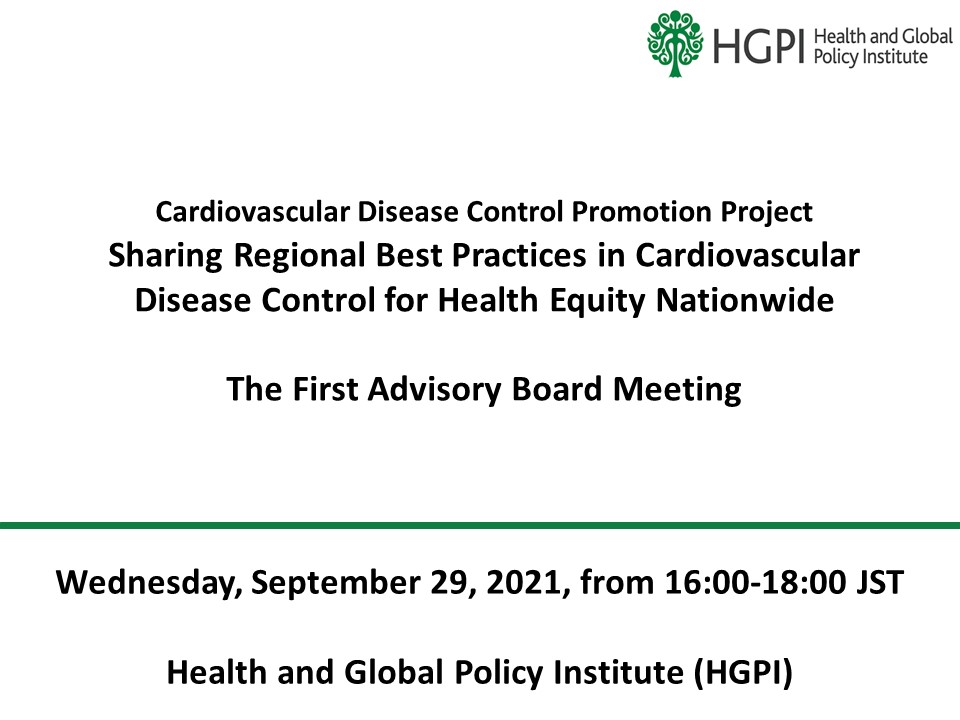[Event Report] The Cardiovascular Disease Control Promotion Project, Phase 2. “Current Issues and Prospects for Advancing Cardiovascular Disease Control Promotion Plans in Each Prefecture” (March 15, 2023)
date : 3/15/2023
Tags: Cardiovascular Diseases, NCDs
![[Event Report] The Cardiovascular Disease Control Promotion Project, Phase 2. “Current Issues and Prospects for Advancing Cardiovascular Disease Control Promotion Plans in Each Prefecture” (March 15, 2023)](https://hgpi.org/en/wp-content/uploads/sites/2/ncd-cd-20230315-top-scaled-1.jpg)
Health and Global Policy Institute (HGPI) hosted the Kyushu-Shikoku Summit on Promoting Measures for CVD Control as our first meeting to advance CVD control measures that leverage the unique aspects of each region and to share lessons and good examples accumulated in each municipality.
HGPI has crystallized the discussion points related to topics that were shared at the Summit as well as their future prospects. (※For further information, please see the PDF file below.)
Overview of Discussion Points
- Discussion point 1: Although all prefectural governments have been obligated to formulate and implement Plans for Promotion of Measures Against Cerebrovascular and Cardiovascular Disease (hereinafter, “CVD Control Plans”), they must also formulate many other plans regarding health and medical care. This is causing challenges when making each CVD Control Plan unique and consistent with other plans.
- Discussion point 2: Each prefecture is examining and formulating CVD Control Plans utilizing logic models, and the final outcomes of those logic models as well as indicators and other items for evaluating them must be fine-tuned to ensure they are tailored to each prefecture’s issues.
- Discussion point 3: Issues that have been identified for proactively implementing the national Government’s Model Projects for Integrated Centers for Stroke and Heart Disease Support (hereinafter, “model projects”) in each prefecture include understanding and collaboration among health institutions, university hospitals, and other institutions that will work together with prefectural governments. Another issue is securing and developing human resources needed for collaboration between the public sector, academia, and the health sector. Model projects that promote collaboration between these three sectors in each prefecture must be designed.
- Discussion Point 4: The national Government’s model projects are useful for ensuring equity in CVD control measures and some prefectures are now discussing funding their own successor projects to continue them. Those successor projects will require sufficient funding from the national Government over multiple years.
- Discussion Point 5: As each prefecture moves forward on implementing its CVD Control Plan, there have been cases in which agreements to collaborate with private companies have been formed. The lack of criteria for selecting private companies to collaborate with may become an issue.
- Discussion Point 6: After each prefecture formulates its CVD Control Plan, it will be necessary for various departments at each prefectural government to advance a wide range of initiatives over time, so monitoring and evaluating internal progress may become a challenge.
- Discussion Point 7: To promote patient and public involvement (PPI) in the field of CVDs, it will be necessary to grasp circumstances surrounding CVD patient advocacy organizations in each prefecture while providing sufficient information to patients and other affected parties so they can actively participate in discussions on CVD Control Plans.
- Discussion Point 8: A platform that enables each prefecture to cross reference its initiatives with those of other prefectures must be established.
Top Research & Recommendations Posts
- [Research Report] Perceptions, Knowledge, Actions and Perspectives of Healthcare Organizations in Japan in Relation to Climate Change and Health: A Cross-Sectional Study (November 13, 2025)
- [Research Report] The 2025 Public Opinion Survey on Healthcare in Japan (March 17, 2025)
- [Policy Recommendations] Developing a National Health and Climate Strategy for Japan (June 26, 2024)
- [Policy Recommendations] Mental Health Project: Recommendations on Three Issues in the Area of Mental Health (July 4, 2025)
- [Announcement] HGPI Endorses the “Belém Health Action Plan” (November 14, 2025)
- [Research Report] The 2023 Public Opinion Survey on Satisfaction in Healthcare in Japan and Healthcare Applications of Generative AI (January 11, 2024)
- [Announcement] HGPI Joins Global Green and Healthy Hospitals (August 1, 2023)
- [Publication Report] Planetary Health Promotion Project “Issues Facing Planetary Health and the Role of the Health Sector” (May 10, 2023)
- [Research Report] Survey of Japanese Physicians Regarding Climate Change and Health (December 3, 2023)
- [Policy Recommendations] Reshaping Japan’s Immunization Policy for Life Course Coverage and Vaccine Equity: Challenges and Prospects for an Era of Prevention and Health Promotion (April 25, 2025)
Featured Posts
-
2025-12-11
[Event Report] Core Components of Universal Health Coverage (UHC): Achieving “Healthcare Without Financial Hardship” in Asia-Pacific and Japan (December 5, 2025)
![[Event Report] Core Components of Universal Health Coverage (UHC): Achieving “Healthcare Without Financial Hardship” in Asia-Pacific and Japan (December 5, 2025)](https://hgpi.org/en/wp-content/uploads/sites/2/HGPI_20251210_Core-Components-of-Universal-Health-CoverageUHC-top.jpg)
-
2025-12-12
[Registration Open] Meaningful Involvement Promotion Project Urgent Symposium “The New Takaichi Administration and Central Social Insurance Medical Council Reform – Ensuring Patients’ Voices are Heard” (January 22, 2026)
![[Registration Open] Meaningful Involvement Promotion Project Urgent Symposium “The New Takaichi Administration and Central Social Insurance Medical Council Reform – Ensuring Patients’ Voices are Heard” (January 22, 2026)](https://hgpi.org/en/wp-content/uploads/sites/2/HGPI_20251208_urgent-symposium-1.png)
-
2025-12-12
[Registration Open] (Webinar) The 140th HGPI Seminar “Early Detection to Reduce COPD Disease Burden: Connecting Clinical Frontiers with Health Policy” (January 27, 2026)
![[Registration Open] (Webinar) The 140th HGPI Seminar “Early Detection to Reduce COPD Disease Burden: Connecting Clinical Frontiers with Health Policy” (January 27, 2026)](https://hgpi.org/en/wp-content/uploads/sites/2/hs140-top.png)








